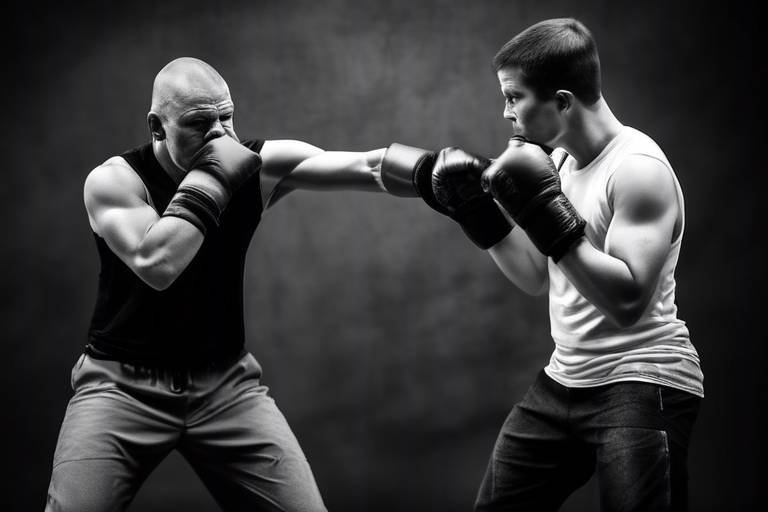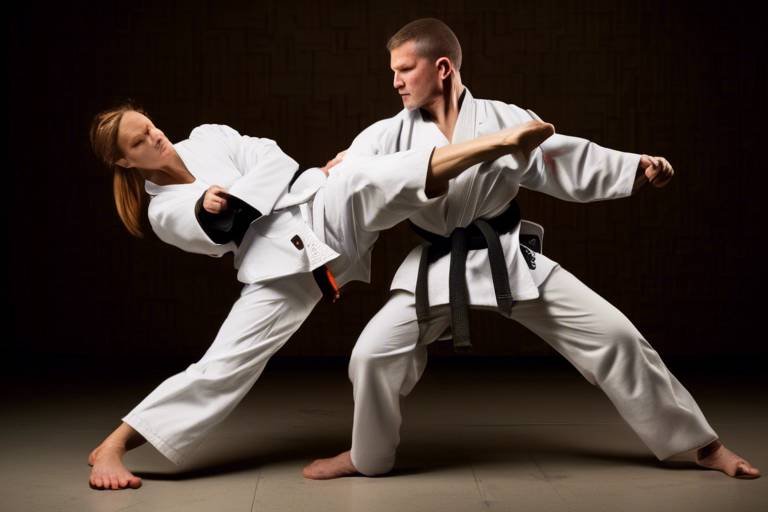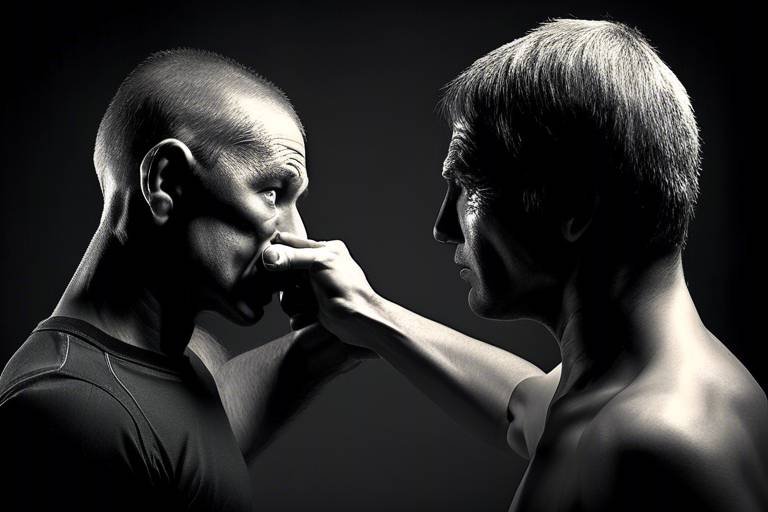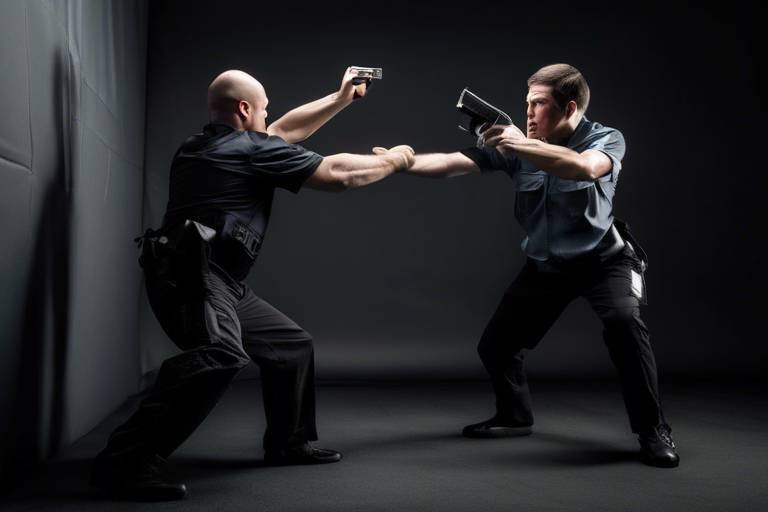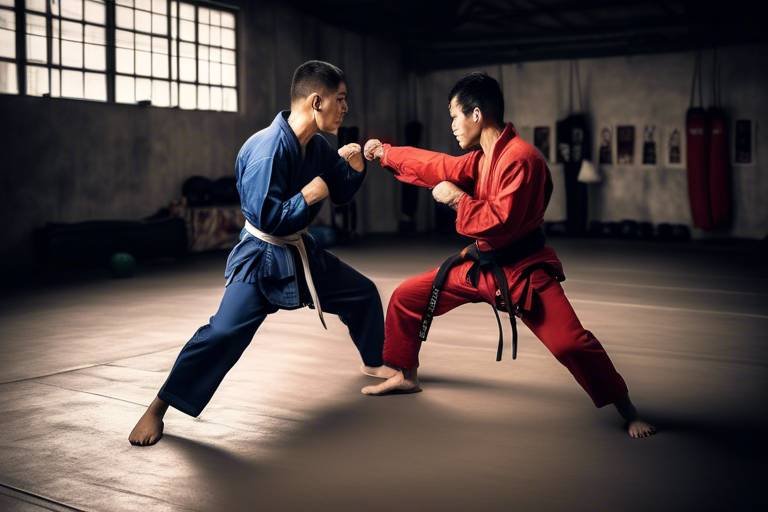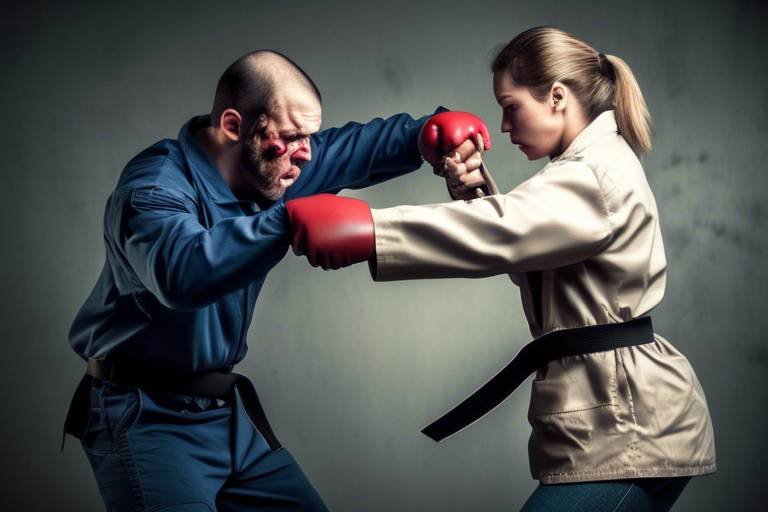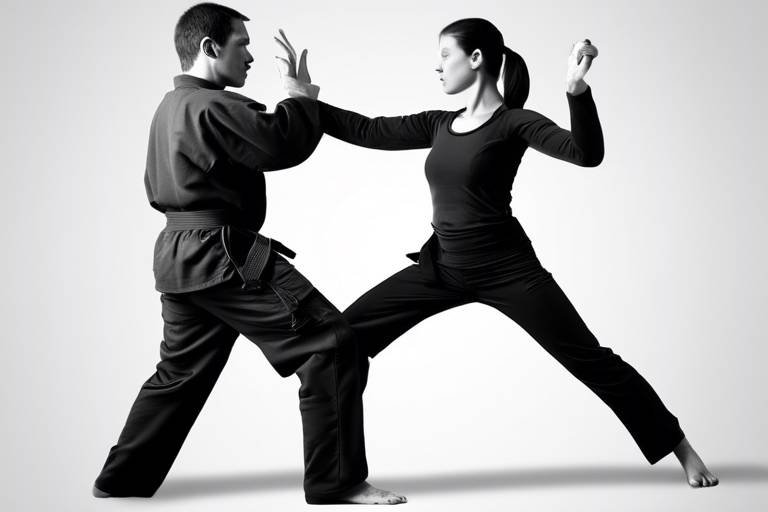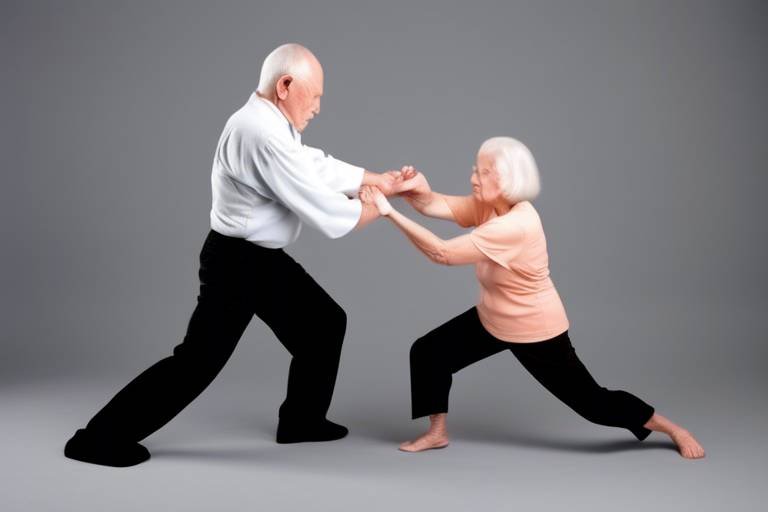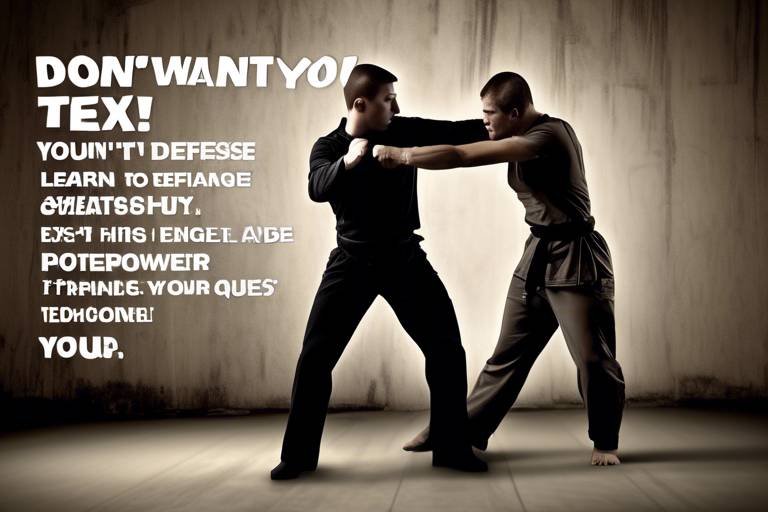Defensive Tactics - Integrating Boxing Moves in Self-Defense Training
In a world where unpredictability reigns, it's essential to equip ourselves with the tools necessary for personal safety. This is where the art of self-defense comes into play. While many forms of martial arts exist, boxing stands out as a particularly effective method for enhancing self-defense strategies. By integrating boxing techniques into your self-defense training, you not only learn to protect yourself but also gain confidence, discipline, and a sense of empowerment. In this article, we will delve into the various boxing moves that can significantly bolster your self-defense skills, providing practical insights and training methods that can be applied in real-life situations.
Understanding the fundamentals of self-defense is crucial in today’s world. With rising incidents of violence and unexpected confrontations, self-defense training serves as a vital shield, empowering individuals to protect themselves effectively. Imagine walking down a dimly lit street and suddenly encountering an aggressive individual. Wouldn’t it be reassuring to know that you possess the skills to handle such a situation? Self-defense training not only prepares you for physical confrontations but also enhances your mental resilience. It teaches you how to assess situations, make quick decisions, and act decisively. Ultimately, being trained in self-defense can mean the difference between escaping a dangerous encounter and becoming a victim.
Boxing provides a solid foundation for self-defense, encompassing a range of techniques that can be effectively utilized in various scenarios. At its core, boxing emphasizes three critical elements: footwork, stance, and basic punches. These fundamentals are not just about throwing punches; they are about positioning yourself effectively to evade attacks while being ready to strike back. By mastering these techniques, you lay the groundwork for a robust self-defense strategy that can adapt to numerous situations. So, let’s break down these essential boxing moves and understand how they can be your best defense.
Effective footwork is vital in both boxing and self-defense. Think of your feet as the foundation of a sturdy house; without a solid base, everything else can crumble. Footwork allows you to move swiftly, evade attacks, and create advantageous angles for striking. Various footwork drills can enhance your mobility and positioning. For instance, practicing the shuffle step can help you move in and out of range quickly, while the pivot can be used to reposition yourself after an attack. Here are a few drills to consider:
- Shadowboxing: Practice moving around an imaginary opponent, focusing on your footwork.
- Agility Ladder Drills: Use an agility ladder to improve your speed and coordination.
- Cone Drills: Set up cones and practice moving around them to enhance your lateral movement.
Adopting the correct stance and guard position is fundamental in boxing and self-defense. Your stance should be balanced, allowing you to move quickly in any direction. A proper guard position protects your vital areas while keeping your hands ready to strike. To maintain an effective guard, keep your elbows close to your body and your hands up near your chin. This positioning not only shields you from incoming attacks but also prepares you to counter effectively. Remember, the goal is to remain relaxed yet alert, ready to respond to any threat that may arise.
Mastering basic punches is essential for effective self-defense. The primary punches you should focus on include:
- Jab: A quick, straight punch that can create distance or set up more powerful strikes.
- Cross: A powerful straight punch thrown with your dominant hand, ideal for delivering significant impact.
- Hook: A punch that comes from the side, targeting the opponent's head or body.
These punches are not just for competition; they can be applied in self-defense situations. For example, a well-timed jab can help you create space between you and an aggressor, allowing you to escape or prepare for a counterattack.
Integrating boxing with other martial arts can significantly enhance your self-defense skills. Techniques from disciplines like Muay Thai or Brazilian Jiu-Jitsu can complement boxing, providing a more comprehensive approach to personal safety. For instance, while boxing focuses on striking, Muay Thai incorporates elbows, knees, and clinch work, which can be invaluable in close-range confrontations. Similarly, Brazilian Jiu-Jitsu offers grappling techniques that can help you control an opponent if the fight goes to the ground. By blending these styles, you create a versatile skill set that prepares you for various scenarios.
Boxing provides numerous benefits that extend beyond physical fitness. Engaging in boxing training not only improves your strength and agility but also enhances your mental and emotional well-being. The discipline required in boxing translates to greater focus and determination in everyday life. Additionally, the adrenaline rush from training sessions can serve as an excellent stress reliever. Let’s explore some of the key benefits:
Training in boxing fosters confidence and resilience. With each punch thrown and each round completed, you build a stronger sense of self. Mastering boxing techniques can empower you to face challenging situations with assurance. Imagine walking into a room full of strangers, and instead of feeling anxious, you exude confidence because you know you can handle yourself. This newfound confidence can positively impact various aspects of your life, from personal relationships to professional endeavors.
Boxing is an excellent workout that improves strength, agility, and endurance. Regular boxing training contributes to overall physical fitness, which is essential for effective self-defense. The combination of cardiovascular workouts, strength training, and agility drills makes boxing one of the most comprehensive fitness regimens available. Not only will you look and feel better, but your body will also be better prepared to react in high-pressure situations.
1. Can anyone learn boxing for self-defense?
Absolutely! Boxing is accessible to individuals of all fitness levels and backgrounds. With proper training and practice, anyone can learn the techniques necessary for self-defense.
2. How long does it take to become proficient in boxing?
The timeline varies for each individual, but with consistent training, you can expect to see significant improvement in a few months.
3. Is boxing safe for self-defense training?
Yes, when practiced under the guidance of a qualified instructor, boxing can be a safe and effective form of self-defense training.
4. Do I need to compete in boxing to benefit from it?
No, many individuals practice boxing solely for fitness and self-defense without ever stepping into a ring.

The Importance of Self-Defense Training
In a world where unpredictability lurks around every corner, understanding self-defense is not just a skill; it's an essential part of personal empowerment. Imagine walking down a quiet street and suddenly feeling a sense of vulnerability. That’s where self-defense training comes into play. It's like having an invisible shield that can protect you when the unexpected happens. Self-defense isn’t just about physical techniques; it’s about cultivating a mindset that keeps you alert and aware of your surroundings.
Self-defense training equips individuals with the skills to react effectively in threatening situations. It’s a way to regain control over one’s safety and well-being. Many people think self-defense is only for those who are athletic or have prior combat experience, but that couldn’t be further from the truth. Whether you're a seasoned athlete or someone just starting out, self-defense training can be tailored to fit your unique needs and abilities. By learning how to defend yourself, you’re not just preparing for potential confrontations; you’re also fostering a sense of confidence that permeates other areas of your life.
Moreover, self-defense training provides invaluable lessons in awareness and prevention. It teaches you to recognize potential threats and avoid dangerous situations before they escalate. Think of it like learning to read the warning signs of a storm before it hits. You wouldn't wait for the clouds to darken before seeking shelter, right? Similarly, being proactive about your safety can make all the difference.
To further illustrate the importance of self-defense training, consider the following benefits:
- Increased Awareness: Training helps you develop a keen sense of your environment, allowing you to identify potential threats.
- Empowerment: Knowing you can defend yourself boosts self-esteem and creates a sense of control.
- Physical Fitness: Self-defense training is a great way to stay active and improve overall health.
- Stress Relief: Engaging in physical activity can reduce stress and anxiety, promoting mental well-being.
In the end, self-defense training is more than just learning how to throw a punch or execute a kick. It’s about building a holistic approach to personal safety that includes mental readiness, physical capability, and emotional resilience. So, whether you're looking to boost your confidence, improve your fitness, or simply learn how to protect yourself, investing in self-defense training is a step in the right direction. After all, the best defense is a good offense, and being prepared can turn a potential victim into a confident survivor.

When it comes to self-defense, having a solid foundation in boxing can be a game changer. Boxing isn't just about throwing punches; it's about understanding the mechanics of movement, timing, and distance. Imagine being in a situation where you need to defend yourself. Wouldn't it be reassuring to know that you have the skills to react effectively? That's where boxing fundamentals come into play. By mastering essential techniques, you can significantly increase your chances of staying safe.
One of the first things to grasp in boxing is footwork. Think of footwork as the dance of boxing; it's all about positioning and mobility. Good footwork allows you to move in and out of range quickly, making it harder for an opponent to land a hit. For example, if someone tries to grab you, being light on your feet can help you sidestep and create distance. Practicing drills such as ladder drills or shadowboxing can enhance your footwork, making you a more agile defender.
Next, let's talk about your stance and guard position. Adopting the correct stance is fundamental to both offense and defense. A proper stance keeps you balanced and ready to react. Your feet should be shoulder-width apart, with one foot slightly forward. This positioning not only prepares you to strike but also allows you to evade attacks effectively. When it comes to your guard, keep your hands up to protect your face while also being ready to throw punches. The guard position is like a shield; it protects you while allowing you to launch your own counter-attacks.
Now, we can't forget about the basic punching techniques. Mastering punches like jabs, crosses, and hooks is crucial for self-defense. The jab, for instance, is not just a way to score points in a match; it's an effective way to create space and keep an aggressor at bay. A well-placed jab can disrupt an attack, giving you the chance to escape or follow up with stronger strikes. Learning how to throw these punches correctly can be the difference between being overwhelmed and taking control of a situation.
Integrating these boxing fundamentals into your self-defense training can create a well-rounded skill set. However, boxing doesn't exist in a vacuum. Combining these techniques with elements from other martial arts, such as Muay Thai or Brazilian Jiu-Jitsu, can enhance your effectiveness even further. Each discipline offers unique strategies that can complement your boxing skills, making you a more versatile defender.
In summary, the fundamentals of boxing—footwork, stance, guard position, and basic punches—are essential tools in your self-defense arsenal. By focusing on these areas, you not only prepare yourself physically but also instill a sense of confidence and readiness. Remember, being equipped with these skills means you can handle unexpected situations with poise and assurance. So, are you ready to step into the ring of self-defense and take your training to the next level?
- What is the best way to start learning boxing for self-defense? Begin with basic classes focusing on footwork and punching techniques. Practice regularly to build muscle memory.
- Can boxing techniques be effective against larger opponents? Yes, effective footwork and strategy can help you evade attacks and create openings, regardless of size.
- How often should I train in boxing for self-defense? Consistency is key. Aim for at least 2-3 times a week to build your skills and confidence.

Footwork Techniques
When it comes to self-defense, footwork is often the unsung hero. Imagine a dance floor where every move counts; this is how crucial footwork is in both boxing and self-defense. It’s not just about throwing punches; it’s about how you position yourself to avoid danger and create opportunities to strike back. Effective footwork can mean the difference between dodging an attack and getting caught off guard. So, let’s explore some essential footwork techniques that can enhance your self-defense capabilities.
First off, let’s talk about the basic movement patterns. In boxing, you’ll often hear about the importance of maintaining a balanced stance. This means your feet should be shoulder-width apart, allowing for quick lateral movements. Practicing the step-and-slide technique can help you maintain that balance while being agile. Essentially, you want to be able to move in any direction without losing your footing, just like a cat ready to pounce!
Another vital aspect of footwork is the pivot. Imagine you’re in a situation where your attacker is coming at you from the side. A quick pivot can help you turn your body away from the incoming threat while keeping your eyes on your opponent. This technique not only allows you to evade attacks but also positions you for a counter-strike. To practice this, try working on the following drills:
- Shadowboxing: Focus on moving around your space, practicing pivots and steps as if you were in a real fight.
- Agility Ladder Drills: Use an agility ladder to improve your foot speed and coordination, which are essential for quick movements.
- Partner Drills: Work with a partner to practice evading attacks using footwork. This simulates real-life scenarios and helps you react instinctively.
Now, let’s not forget about the importance of distance management. In self-defense, knowing how far you are from your attacker can dictate your next move. If you’re too close, you risk getting hit; if you’re too far, you might miss your opportunity to strike. Understanding how to close the distance effectively is key. You can practice this by using a shadowboxing technique where you visualize an opponent and move in and out of range, focusing on your foot placement and timing.
To wrap it up, mastering footwork is like learning to ride a bike; once you get it, it becomes second nature. The more you practice, the more instinctive your movements will become. Remember, in a self-defense situation, your feet are your first line of defense. So, lace up those boxing shoes, hit the gym, and start incorporating these footwork techniques into your training. You’ll not only improve your boxing skills but also enhance your overall self-defense capabilities.
Q1: How does footwork improve my self-defense skills?
A1: Footwork enhances your mobility, allowing you to evade attacks and position yourself effectively for a counter-strike. It helps you maintain balance and control during a confrontation.
Q2: Can I practice footwork at home?
A2: Absolutely! You can practice footwork drills such as shadowboxing, agility ladder drills, or even just moving around your living space to improve your foot speed and coordination.
Q3: Is footwork more important than punching techniques in self-defense?
A3: Both are crucial, but without effective footwork, your punching techniques may not be as effective. Good footwork allows you to create distance, evade attacks, and set up your strikes.

Stance and Guard Position
When it comes to self-defense, the stance and guard position are your first lines of defense. Think of your stance as the foundation of a house; if it's not solid, everything else can crumble. A proper stance allows you to maintain balance, move quickly, and react effectively to any situation. So, how do you achieve this? First, you want to stand with your feet shoulder-width apart, which gives you stability. Your knees should be slightly bent, ready to spring into action.
Now, let's talk about the guard position. This is where your hands come into play. You want to keep your hands up, protecting your face and head, while your elbows are tucked in to shield your body. Imagine you're holding a shield in front of you; that’s the essence of a good guard. This not only protects you from incoming strikes but also positions you to deliver your own punches. The classic guard position involves keeping your fists near your cheeks, ready to block or counterattack.
To make things clearer, here’s a simple comparison table that outlines the differences between an effective stance and a poor stance:
| Aspect | Effective Stance | Poor Stance |
|---|---|---|
| Foot Position | Shoulder-width apart | Narrow or too wide |
| Knee Position | Slightly bent | Locked or overly bent |
| Hand Position | Fists near the face | Hands down or too far away |
| Balance | Stable and ready to move | Unstable and rigid |
Practicing your stance and guard position regularly is crucial. You can incorporate this into your training routine by practicing in front of a mirror or with a partner. This way, you can receive feedback on your posture and make necessary adjustments. Remember, the goal is to be both defensive and offensive; a strong guard allows you to absorb attacks while positioning you to counter effectively.
In conclusion, mastering your stance and guard position is not just about looking good; it's about creating a solid foundation for your self-defense strategy. By integrating these techniques into your training, you’ll find yourself more confident and prepared to handle unexpected situations. So, the next time you step into the training ring or practice your moves at home, focus on your stance and guard like your safety depends on it—because it truly does!
- What is the best stance for self-defense? The best stance is one that offers balance and mobility, typically with feet shoulder-width apart and knees slightly bent.
- How do I maintain a good guard position? Keep your hands up near your face and your elbows tucked in to protect your body.
- Can I practice my stance and guard at home? Absolutely! Use a mirror or practice with a partner to refine your techniques.
- Why is footwork important in self-defense? Good footwork allows you to move quickly, evade attacks, and position yourself for counterattacks.

Basic Punching Techniques
When it comes to self-defense, mastering is not just about throwing a fist; it's about understanding the mechanics behind each strike and how they can be effectively applied in real-life situations. The three fundamental punches every aspiring self-defender should learn are the jab, cross, and hook. Each of these punches serves a unique purpose and can be adapted depending on the scenario.
The jab is often considered the most important punch in boxing. It’s quick, versatile, and can create distance between you and an aggressor. Imagine it as a way to keep your opponent at bay while setting up for a more powerful strike. To throw a jab, extend your lead hand straight out while rotating your shoulder slightly. This motion not only helps in maintaining distance but also allows you to gauge your opponent's intentions.
Next up is the cross, which is typically thrown with your rear hand. This punch carries a lot of power and is often used as a follow-up to the jab. When executed correctly, the cross can be a game-changer in a self-defense situation. To perform a cross, pivot your back foot and rotate your hips as you throw the punch, ensuring that you’re transferring your body weight into the strike. This technique not only enhances your power but also positions you for a quick retreat or follow-up move.
Lastly, the hook is a punch that can catch an opponent off-guard, especially in close quarters. It’s thrown in a circular motion and is particularly effective when an attacker is trying to close the distance. To execute a hook, keep your elbow at shoulder height and swing your arm in a horizontal arc. This technique is great for targeting the side of an opponent’s head or body, and when delivered with precision, it can be a decisive blow.
To further illustrate these techniques, here's a
| Punch Type | Description | Best Use |
|---|---|---|
| Jab | Quick, straight punch from the lead hand | Maintaining distance and setting up other punches |
| Cross | Powerful punch from the rear hand | Follow-up after a jab or as a counter |
| Hook | Circular punch targeting the side | Close-range encounters, catching opponents off-guard |
Incorporating these basic punching techniques into your self-defense training can significantly enhance your ability to respond to threats. Remember, it’s not just about throwing punches; it’s about understanding when and how to use them effectively. Practice these techniques regularly, and you’ll build muscle memory that could prove invaluable in a real-life situation.
- Can anyone learn boxing techniques for self-defense? Absolutely! Boxing techniques can be learned by anyone, regardless of age or fitness level. It’s all about practice and consistency.
- How often should I practice these punching techniques? Ideally, you should incorporate these techniques into your training at least 2-3 times a week to build muscle memory and improve your skills.
- Do I need special equipment to practice these punches? While gloves and pads can enhance your training, you can start practicing with just your hands and a mirror to check your form.

Combining Boxing with Other Martial Arts
When it comes to self-defense, the age-old adage "knowledge is power" rings true. But what if you could amplify that power by combining different martial arts? Boxing is a fantastic foundation for self-defense, but integrating it with other disciplines can elevate your skills to a whole new level. Imagine stepping into a situation where your boxing footwork allows you to evade an attack, while your knowledge of Brazilian Jiu-Jitsu helps you grapple effectively if the fight goes to the ground. This synergy between boxing and other martial arts can truly be a game-changer.
One of the most common pairings is boxing with Muay Thai. Known as the "Art of Eight Limbs," Muay Thai incorporates punches, kicks, elbows, and knees, creating a well-rounded striking system. By integrating boxing’s quick jabs and footwork with Muay Thai's devastating kicks and clinch techniques, you can develop a versatile striking style that keeps your opponents guessing. For instance, while a boxer might rely on quick head movement to avoid punches, a Muay Thai practitioner can use their elbows in close quarters to create space and counterattack.
Moreover, adding grappling arts like Brazilian Jiu-Jitsu can be immensely beneficial. In a self-defense scenario, it’s not uncommon for a confrontation to go to the ground. Here, boxing's striking techniques can serve as a powerful initial defense, allowing you to create distance before transitioning into grappling. Understanding how to control an opponent on the ground, while also having the striking ability to fend them off initially, offers a comprehensive self-defense strategy. This combination can be particularly effective in real-life situations where the unpredictability of an encounter is high.
To illustrate the benefits of combining boxing with other martial arts, consider the following table:
| Martial Art | Key Benefits | How It Complements Boxing |
|---|---|---|
| Muay Thai | Utilizes elbows, knees, and clinch work. | Enhances striking versatility and close combat skills. |
| Brazilian Jiu-Jitsu | Focuses on ground control and submissions. | Provides grappling skills for ground defense. |
| Krav Maga | Emphasizes real-world self-defense techniques. | Teaches how to defend against armed attackers and multiple assailants. |
Incorporating techniques from these martial arts not only broadens your skill set but also helps in developing a more adaptable mindset. You learn to think on your feet, assessing the situation and responding with the appropriate technique, whether it be a swift jab, a powerful kick, or a grappling maneuver. This mental flexibility is just as crucial as the physical skills you develop, making you a more formidable opponent in any scenario.
In conclusion, combining boxing with other martial arts creates a well-rounded self-defense strategy that prepares you for various situations. By embracing the strengths of multiple disciplines, you not only enhance your physical abilities but also cultivate a mindset geared towards adaptability and resilience. So, why limit yourself to just one style when the world of martial arts offers such a rich tapestry of techniques? Embrace the blend, and watch your self-defense skills soar!
- Can I practice boxing and other martial arts simultaneously? Yes, many practitioners train in multiple disciplines to enhance their overall skills.
- Is boxing effective for self-defense? Absolutely! Boxing techniques, especially footwork and striking, are highly effective in self-defense situations.
- What other martial arts complement boxing? Muay Thai, Brazilian Jiu-Jitsu, and Krav Maga are excellent choices for those looking to expand their self-defense skills.

Benefits of Boxing in Self-Defense
Boxing is not just a sport; it’s a powerful tool for self-defense that offers a plethora of benefits that extend beyond mere physical prowess. When you integrate boxing into your self-defense training, you’re not just learning how to throw a punch; you’re developing a comprehensive skill set that enhances your overall ability to protect yourself. Let's dive into the multifaceted advantages of boxing as a self-defense mechanism.
One of the most significant benefits of boxing is its ability to build confidence and resilience. Imagine walking down the street, and suddenly, you feel a surge of anxiety at the thought of a potential confrontation. Now, picture yourself having trained in boxing; that anxiety transforms into assurance. When you master boxing techniques, you gain a sense of control over your body and your reactions. This newfound confidence doesn't just help in physical confrontations; it seeps into other areas of your life, empowering you to tackle challenges head-on.
Moreover, boxing training is a fantastic way to enhance your physical fitness. Regular boxing workouts are not just about throwing punches; they incorporate a variety of exercises that improve your strength, agility, and endurance. For instance, consider the following table that outlines the key physical attributes developed through boxing training:
| Physical Attribute | Description |
|---|---|
| Strength | Boxing workouts build muscle strength, especially in the upper body, core, and legs. |
| Agility | Footwork drills enhance your ability to move quickly and change direction. |
| Endurance | High-intensity training improves cardiovascular health and stamina. |
This combination of strength, agility, and endurance is crucial in self-defense situations, where physical capabilities can make a significant difference. The more physically prepared you are, the better equipped you will be to handle unexpected encounters.
Another noteworthy advantage of boxing in self-defense is the emphasis on mental toughness. Boxing isn’t just a physical battle; it’s a mental one as well. During training, you’ll face challenges that push you to your limits, teaching you how to stay calm under pressure. This mental fortitude is invaluable in real-life confrontations, where panic can often lead to poor decisions. By training your mind to stay focused and composed, you’re essentially preparing yourself to think clearly when it matters the most.
Lastly, boxing encourages a sense of community and support among practitioners. When you train in a boxing gym, you become part of a network of like-minded individuals who share the goal of personal safety and empowerment. This camaraderie can be incredibly motivating, pushing you to train harder and stay committed to your self-defense journey. Plus, it’s reassuring to know that you’re not alone in your quest for self-improvement and safety.
In conclusion, the benefits of incorporating boxing into your self-defense training are vast and impactful. From building confidence and physical fitness to fostering mental resilience and community support, boxing equips you with the tools necessary to face any situation with strength and assurance. So, are you ready to step into the ring and take your self-defense skills to the next level?
- Can anyone learn boxing for self-defense? Absolutely! Boxing techniques can be adapted for individuals of all skill levels, making it accessible to everyone.
- How often should I train to see results? Ideally, training two to three times a week can yield significant improvements in your skills and fitness.
- Is boxing training safe? When done under professional supervision and with proper techniques, boxing training is generally safe and can even help prevent injuries.

Building Confidence and Resilience
When it comes to self-defense, confidence and resilience are your best allies. Imagine standing tall, feeling the strength in your muscles, and knowing that you can handle whatever life throws your way. This is what boxing training offers you. It’s not just about throwing punches; it’s about building a mindset that prepares you for challenges both in and out of the ring. Every jab you throw and every dodge you make contributes to a growing sense of self-assurance.
Boxing is a powerful tool for personal development. Each training session is a mini-battle against your own limitations. You learn to push through fatigue, to keep your guard up even when you feel like giving in, and this translates directly to life outside the gym. It’s like developing a mental armor that protects you from doubt and fear. You start to realize that you are capable of much more than you previously thought. This newfound resilience can be a game-changer in high-pressure situations, whether you're facing a physical confrontation or dealing with everyday stressors.
Moreover, the community aspect of boxing training can also enhance your confidence. Being surrounded by supportive trainers and fellow boxers creates an environment where you can share your fears and triumphs. You’re not just training alone; you’re part of a team that celebrates your progress. This camaraderie fosters a sense of belonging, which is crucial for emotional well-being. It’s like having a safety net that catches you when you stumble, reminding you that you’re not alone in your journey.
So how does boxing specifically build this confidence and resilience? Here are a few key points:
- Skill Mastery: As you learn and master different techniques, you gain a sense of accomplishment that boosts your self-esteem.
- Physical Fitness: Improved strength and endurance make you feel more capable, both in and out of the ring.
- Stress Relief: Hitting the pads or the bag can be a great way to release pent-up stress, leading to a clearer mind.
- Goal Setting: Achieving small goals in training, like perfecting a punch or increasing your rounds, builds a habit of success.
In essence, boxing isn’t just a sport; it’s a transformative experience. The skills you learn in the ring can empower you to face life’s challenges with a newfound vigor. You become not just a fighter in the physical sense, but a warrior in your own life. Each punch thrown is a step towards greater self-confidence, and each round completed is a testament to your resilience. So, lace up those gloves and step into the ring; you might just discover a stronger version of yourself waiting to emerge.
| Question | Answer |
|---|---|
| How often should I train in boxing for self-defense? | Training 2-3 times a week is ideal to build skills and confidence. |
| Can boxing help me in other martial arts? | Absolutely! Boxing techniques can enhance your striking skills in various martial arts disciplines. |
| Do I need to be fit to start boxing? | No, boxing training is suitable for all fitness levels, and it will help you improve your fitness over time. |
| Is boxing training safe? | When done with proper techniques and under supervision, boxing training is generally safe and very beneficial. |

Enhancing Physical Fitness
When it comes to self-defense, being physically fit is not just a bonus; it’s a fundamental necessity. Boxing, as a form of training, offers an incredible way to boost your overall physical fitness while also preparing you for real-life confrontations. Think of boxing as a full-body workout that not only tones your muscles but also enhances your cardiovascular health. It’s like hitting two birds with one stone—improving your fitness and learning how to defend yourself at the same time!
One of the most significant benefits of boxing training is its ability to increase strength. The repetitive motions of throwing punches and engaging in sparring sessions target various muscle groups, leading to increased muscle mass and improved endurance. Your arms, shoulders, and core become stronger, allowing you to deliver powerful strikes when necessary. But it doesn’t stop there; your legs also get a workout from the constant movement and footwork drills, which help build lower body strength and stability.
Moreover, boxing is a fantastic way to improve agility and coordination. The sport demands quick reflexes and the ability to move fluidly in and out of striking range. By practicing footwork drills and shadow boxing, you enhance your body’s ability to react swiftly to threats. This agility not only helps in self-defense but also translates into better performance in other physical activities, whether it’s playing sports or simply keeping up with your kids!
Another critical aspect of boxing is its impact on cardiovascular fitness. Engaging in high-intensity workouts, such as bag work and sparring, elevates your heart rate, improving your heart and lung capacity over time. This increase in cardiovascular endurance means you can maintain your energy levels during a confrontation, allowing you to think clearly and act decisively. In essence, boxing trains your body to perform under pressure, which is invaluable in self-defense situations.
To give you a clearer picture of how boxing enhances physical fitness, here’s a quick breakdown of the key fitness components you can expect to improve:
| Fitness Component | Benefits |
|---|---|
| Strength | Increased muscle mass and power for delivering effective strikes. |
| Agility | Improved reflexes and movement, enabling quick responses to threats. |
| Cardiovascular Fitness | Enhanced heart and lung capacity for sustained energy during confrontations. |
| Endurance | Ability to maintain physical activity over extended periods, crucial in self-defense. |
In addition to these physical benefits, boxing also has a profound mental impact. The discipline required in training fosters a strong mindset, teaching you to push through challenges and setbacks. This mental toughness is essential not only in boxing but in life as well. When you learn to overcome the physical demands of boxing, you build resilience that can help you face various challenges outside the gym.
So, if you're looking to enhance your physical fitness while simultaneously equipping yourself with essential self-defense skills, boxing is the way to go. It’s not just about throwing punches; it’s about building a stronger, faster, and more confident version of yourself. Remember, in the world of self-defense, being prepared physically can make all the difference!
- How often should I train boxing for self-defense?
To see significant improvements, aim for at least 2-3 times a week. Consistency is key! - Do I need prior experience to start boxing?
No prior experience is necessary! Boxing classes cater to all skill levels. - Can boxing help me lose weight?
Absolutely! Boxing is an excellent calorie-burning workout that can aid in weight loss. - Is boxing safe for self-defense training?
Yes, when taught by a qualified instructor, boxing techniques can be practiced safely and effectively.
Frequently Asked Questions
- What are the key benefits of integrating boxing into self-defense training?
Integrating boxing into self-defense training offers numerous benefits, such as improved physical fitness, enhanced reflexes, and increased confidence. Boxing techniques like footwork and punching can help individuals effectively evade attacks and deliver powerful counterstrikes, making them better prepared for real-life confrontations.
- Can boxing techniques be applied in real self-defense situations?
Absolutely! Boxing techniques are highly practical for self-defense. The skills learned in boxing, such as maintaining a proper stance, effective footwork, and executing quick punches, can be directly applied in various self-defense scenarios, allowing individuals to protect themselves more effectively.
- How does footwork contribute to self-defense?
Footwork is crucial in self-defense as it allows you to maintain distance, evade attacks, and position yourself for a counterattack. By mastering footwork techniques from boxing, you can enhance your mobility, making it harder for an attacker to reach you while enabling you to strike back effectively.
- Is boxing training suitable for everyone?
Yes, boxing training can be adapted for people of all fitness levels and ages. Whether you’re a beginner or someone with prior experience, boxing offers a variety of drills and techniques that can be tailored to meet individual needs, making it an accessible form of self-defense training.
- How does boxing help build mental resilience?
Boxing training challenges individuals both physically and mentally. As you learn to face opponents, overcome fatigue, and push through discomfort, you develop mental resilience. This newfound strength can translate into greater confidence and the ability to handle stressful situations outside the ring.
- What should I focus on as a beginner in boxing for self-defense?
As a beginner, focus on mastering the basics: your stance, guard position, and fundamental punches like jabs and crosses. Additionally, practice footwork drills to improve your mobility. These foundational skills are essential for building a solid self-defense strategy.
- Can boxing be combined with other martial arts?
Yes! Combining boxing with other martial arts like Muay Thai or Brazilian Jiu-Jitsu can enhance your self-defense skills. Each discipline brings unique techniques and perspectives, allowing you to create a more comprehensive self-defense strategy that utilizes striking, grappling, and ground techniques.
- What physical fitness benefits can I expect from boxing training?
Boxing training provides a full-body workout that improves strength, endurance, and agility. Regular practice can lead to increased cardiovascular fitness, better muscle tone, and enhanced overall physical health, all of which are crucial for effective self-defense.

